Hybrid VMD–BiGRU Framework for Multi-Step Forecasting of PM2.5 in Traffic-Intensive Cities of the Kingdom of Saudi Arabia
Abstract
1. Introduction
1.1. PM2.5: The Invisible Threat
1.2. Rationale of Proposed Study
- Application of the VMD approach to extract multi-scale temporal components from complex PM2.5 time series data in Riyadh, Jeddah, and Dammam, KSA.
- Development of a hybrid VMD–BiGRU framework optimized through Bayesian Optimization (BO) for short-term PM2.5 prediction.
- Implementation of a one- to seven-day ahead multi-step forecasting scheme to evaluate short-term PM2.5 prediction performance across the three cities.
- Comparison of the proposed VMD–BiGRU framework with competitive models, including VMD–GRU, VMD–LSTM, and VMD–TCN, to assess predictive accuracy and stability.
2. Materials and Methods
2.1. Study Location and Data
2.2. Theoretical Overview of the VMD–BiGRU Framework
2.2.1. PM2.5 Time Series Decomposition via VMD
2.2.2. BO-Optimized BiGRU-Based LEARNING
2.2.3. Predicted Signal Reconstruction
2.3. Performance Measures
3. Results and Discussion
3.1. Multi-Horizon Performance Assessment of VMD-BiGRU Framework
3.2. Comparison with Other Models
4. Conclusions and Recommendations
Author Contributions
Funding
Institutional Review Board Statement
Informed Consent Statement
Data Availability Statement
Conflicts of Interest
Appendix A
| Models and Indicator | t + 1 | t + 2 | t + 3 | t + 4 | t + 5 | t + 6 | t + 7 |
|---|---|---|---|---|---|---|---|
| VMD–BiGRU_RMSE | 9.2 | 12.1 | 15.8 | 17.4 | 23.7 | 28.5 | 31.9 |
| VMD–BiGRU_MAE | 7.3 | 10 | 13 | 14 | 19 | 23 | 26 |
| VMD–BiGRU_R2 | 0.97 | 0.947 | 0.906 | 0.89 | 0.792 | 0.717 | 0.665 |
| VMD–BiLSTM_RMSE | 10.8 | 13.9 | 17.2 | 18.9 | 25.8 | 30.1 | 33.6 |
| VMD–BiLSTM_MAE | 8.5 | 11.3 | 14.4 | 15.5 | 20.5 | 24.4 | 27.2 |
| VMD–BiLSTM_R2 | 0.953 | 0.935 | 0.894 | 0.876 | 0.776 | 0.702 | 0.645 |
| VMD–GRU_RMSE | 11 | 14.2 | 17.6 | 19.3 | 26.3 | 30.7 | 34.1 |
| VMD–GRU_MAE | 8.7 | 11.6 | 14.7 | 15.8 | 20.9 | 24.9 | 27.8 |
| VMD–GRU_R2 | 0.948 | 0.929 | 0.887 | 0.868 | 0.768 | 0.695 | 0.639 |
| VMD–TCN_RMSE | 11.4 | 14.8 | 18.1 | 19.9 | 26.8 | 31.2 | 34.7 |
| VMD–TCN_MAE | 9.1 | 12 | 15.1 | 16.2 | 21.4 | 25.5 | 28.3 |
| VMD–TCN_R2 | 0.942 | 0.923 | 0.88 | 0.861 | 0.761 | 0.688 | 0.632 |
References
- Rao, M.N.; Ghude, S.S.; Nivdange, S.S.; Panchang, R.; Pipal, A.S.; Mukherjee, A.; Sharma, H.; Kumar, V. Characterization and health risk assessment of airborne microplastics in Delhi NCR. Sci. Rep. 2025, 15, 25662. [Google Scholar] [PubMed]
- Zaręba, Ł.; Piszczatowska, K.; Dżaman, K.; Soroczynska, K.; Motamedi, P.; Szczepański, M.J.; Ludwig, N. The relationship between fine particle matter (PM2.5) exposure and upper respiratory tract diseases. J. Pers. Med. 2024, 14, 98. [Google Scholar] [CrossRef]
- Hu, A.; Li, R.; Chen, G.; Chen, S. Impact of respiratory dust on health: A comparison based on the toxicity of PM2.5, silica, and nanosilica. Int. J. Mol. Sci. 2024, 25, 7654. [Google Scholar] [CrossRef]
- Ghosh, S.; Sinha, D. Indian perspective of PM2.5 attributed human health hazards during 2010–2025. Air Qual. Atmos. Health 2025, 18, 2765–2804. [Google Scholar] [CrossRef]
- Henning, R.J. Particulate matter air pollution is a significant risk factor for cardiovascular disease. Curr. Probl. Cardiol. 2024, 49, 102094. [Google Scholar] [CrossRef]
- Xu, X.; Huang, L.; Yao, L.; Yoshida, Y.; Long, Y. Rising socio-economic costs of PM2.5 pollution and medical service mismatching. Nat. Sustain. 2025, 8, 265–275. [Google Scholar] [CrossRef]
- World Health Organization. WHO Global Air Quality Guidelines: Particulate Matter (PM2.5 and PM10), Ozone, Nitrogen Dioxide, Sulfur Dioxide and Carbon Monoxide; World Health Organization: Geneva, Switzerland, 2021.
- Penkała, M.; Ogrodnik, P.; Rogula-Kozłowska, W. Particulate matter from the road surface abrasion as a problem of non-exhaust emission control. Environments 2018, 5, 9. [Google Scholar] [CrossRef]
- Sun, J.; Ho, S.S.H.; Niu, X.; Xu, H.; Qu, L.; Shen, Z.; Cao, J.; Chuang, H.-C.; Ho, K.-F. Explorations of tire and road wear microplastics in road dust PM2.5 at eight megacities in China. Sci. Total Environ. 2022, 823, 153717. [Google Scholar] [CrossRef]
- Meo, S.A.; Shaikh, N.; Meo, A.S. Effect of particulate matter (PM2.5, PM10) on deaths and disability-adjusted life years (DALYs) in Gulf Cooperation Council countries: Global burden of disease time trend analysis 1990–2021. Pak. J. Med. Sci. 2025, 41, 2875–2882. [Google Scholar] [CrossRef] [PubMed]
- Alanzi, T.; Aljarbooa, N.; AlSalem, F.; Sawan, R.; Albalawi, B.; Ababtain, G.; Taha, R.; Toonsi, M.; Aloufi, M.; Alsharifa, H. Public perceptions and practices on air quality and respiratory health: Insights from a cross-sectional study in Saudi Arabia. J. Med. Life 2025, 18, 315. [Google Scholar] [CrossRef] [PubMed]
- Alharbi, H.A.; Rushdi, A.I.; Bazeyad, A.; Al-Mutlaq, K.F. Temporal Variations, Air Quality, Heavy Metal Concentrations, and Environmental and Health Impacts of Atmospheric PM2.5 and PM10 in Riyadh City, Saudi Arabia. Atmosphere 2024, 15, 1448. [Google Scholar] [CrossRef]
- Munir, S.; Siddiqui, M.H.; Habeebullah, T.M.; Zamreeq, A.O.; Al-Zahrani, N.E.; Khalil, A.A.; Islam, M.N.; Baligh, A.A.; Ismail, M.; Al-Boqami, S.Z. Variability and Trends of PM2.5 Across Different Climatic Zones in Saudi Arabia: A Spatiotemporal Analysis. Atmosphere 2025, 16, 463. [Google Scholar] [CrossRef]
- Abdelmaksoud, A.; Halawani, R.; Almehmadi, F.; Quicksall, A. Characterization of PM2.5 Trace Metals from the Urban-Coastal Area of Jeddah, Saudi Arabia. Water Air Soil Pollut. 2025, 236, 550. [Google Scholar] [CrossRef]
- Zhang, L.; Liu, J.; Feng, Y.; Wu, P.; He, P. PM2.5 concentration prediction using weighted CEEMDAN and improved LSTM neural network. Environ. Sci. Pollut. Res. 2023, 30, 75104–75115. [Google Scholar] [CrossRef]
- Ban, W.; Shen, L. PM2.5 prediction based on the CEEMDAN algorithm and a machine learning hybrid model. Sustainability 2022, 14, 16128. [Google Scholar] [CrossRef]
- Zeng, Q.; Wang, L.; Zhu, S.; Gao, Y.; Qiu, X.; Chen, L. Long-term PM2.5 concentrations forecasting using CEEMDAN and deep Transformer neural network. Atmos. Pollut. Res. 2023, 14, 101839. [Google Scholar] [CrossRef]
- Ameri, R.; Hsu, C.-C.; Band, S.S.; Zamani, M.; Shu, C.-M.; Khorsandroo, S. Forecasting PM 2.5 concentration based on integrating of CEEMDAN decomposition method with SVM and LSTM. Ecotoxicol. Environ. Saf. 2023, 266, 115572. [Google Scholar] [CrossRef] [PubMed]
- Zhao, N.; Liu, Y.; Vanos, J.K.; Cao, G. Day-of-week and seasonal patterns of PM2.5 concentrations over the United States: Time-series analyses using the Prophet procedure. Atmos. Environ. 2018, 192, 116–127. [Google Scholar] [CrossRef]
- Masood, A.; Ahmad, K. Data-driven predictive modeling of PM2.5 concentrations using machine learning and deep learning techniques: A case study of Delhi, India. Environ. Monit. Assess. 2023, 195, 60. [Google Scholar] [CrossRef]
- Patel, R.; Kumar, A.; Yadav, J.; Singh, M. Stacked deep learning ensemble for time series prediction of PM2.5 levels in Bihar. Urban Clim. 2025, 62, 102521. [Google Scholar] [CrossRef]
- Sharma, D.; Thapar, S.; Masood, A.; Sachdeva, K. Fourier-Enhanced Deep Learning and Machine Learning Models for Predicting Multi-Scale PM2.5 Dynamics in Megacities: A Case Study of Delhi. Earth Syst. Environ. 2025, 1–26. [Google Scholar] [CrossRef]
- Vignesh, P.P.; Jiang, J.H.; Kishore, P. Predicting PM2.5 concentrations across USA using machine learning. Earth Space Sci. 2023, 10, e2023EA002911. [Google Scholar] [CrossRef]
- Qamar, M.S.; Munir, M.F.; Waseem, A. AI for Cleaner Air: Predictive Modeling of PM2.5 Using Deep Learning and Traditional Time-Series Approaches. Comput. Model. Eng. Sci. 2025, 144, 3557. [Google Scholar] [CrossRef]
- Bhatti, U.A.; Yan, Y.; Zhou, M.; Ali, S.; Hussain, A.; Qingsong, H.; Yu, Z.; Yuan, L. Time series analysis and forecasting of air pollution particulate matter (PM2.5): An SARIMA and factor analysis approach. IEEE Access 2021, 9, 41019–41031. [Google Scholar] [CrossRef]
- Kleine Deters, J.; Zalakeviciute, R.; Gonzalez, M.; Rybarczyk, Y. Modeling PM2.5 urban pollution using machine learning and selected meteorological parameters. J. Electr. Comput. Eng. 2017, 2017, 5106045. [Google Scholar] [CrossRef]
- Abdulraheem, K.A.; Aina, Y.A.; Mustapha, I.B.; Adekunle, B.S.; Jimoh, H.O.; Adeniran, J.A.; Olaleye, A.A.; Hamid-Mosaku, I.A.; Nasiru, A.I.; Abimbola, I. Modelling spatiotemporal concentrations of PM2.5 over Nigerian cities using machine learning algorithms and open-source data. Model. Earth Syst. Environ. 2025, 11, 36. [Google Scholar] [CrossRef]
- Abuouelezz, W.; Ali, N.; Aung, Z.; Altunaiji, A.; Shah, S.B.; Gliddon, D. Exploring PM2.5 and PM10 ML forecasting models: A comparative study in the UAE. Sci. Rep. 2025, 15, 9797. [Google Scholar] [CrossRef]
- Zaman, N.A.F.K.; Kanniah, K.D.; Kaskaoutis, D.G.; Latif, M.T. Evaluation of machine learning models for estimating PM2.5 concentrations across Malaysia. Appl. Sci. 2021, 11, 7326. [Google Scholar] [CrossRef]
- Zhu, Q.; Zhang, F.; Liu, S.; Wu, Y.; Wang, L. A hybrid VMD–BiGRU model for rubber futures time series forecasting. Appl. Soft Comput. 2019, 84, 105739. [Google Scholar] [CrossRef]
- Li, S.; Tang, B.; Deng, X. A Hybrid Method Combining Variational Mode Decomposition and Deep Neural Networks for Predicting PM2.5 Concentration in China. IEEE Access 2025, 13, 51956–51968. [Google Scholar] [CrossRef]
- Alsulami, B.T.; Khattak, A. Integrated OVMD-BiGRU-SMAC Framework for Forecasting Construction Accidents in the Kingdom of Saudi Arabia. IEEE Access 2025, 13, 124543–124555. [Google Scholar] [CrossRef]
- Khattak, A.; Chan, P.-W.; Chen, F.; Peng, H. Estimating turbulence intensity along the glide path using wind tunnel experiments combined with interpretable tree-based machine learning algorithms. Build. Environ. 2023, 239, 110385. [Google Scholar] [CrossRef]
- Zhang, S.; Luo, J.; Wang, S.; Liu, F. Oil price forecasting: A hybrid GRU neural network based on decomposition–reconstruction methods. Expert Syst. Appl. 2023, 218, 119617. [Google Scholar] [CrossRef]
- Han, L.; Zhang, R.; Wang, X.; Bao, A.; Jing, H. Multi-step wind power forecast based on VMD-LSTM. IET Renew. Power Gener. 2019, 13, 1690–1700. [Google Scholar] [CrossRef]
- Geng, G.; He, Y.; Zhang, J.; Qin, T.; Yang, B. Short-term power load forecasting based on PSO-optimized VMD-TCN-attention mechanism. Energies 2023, 16, 4616. [Google Scholar] [CrossRef]
- Alharbi, H.A.; Rushdi, A.I.; Bazeyad, A.; Al-Mutlaq, K.F. Polycyclic Aromatic Hydrocarbons in Atmospheric PM2.5 and PM10 of Riyadh City, Saudi Arabia: Levels, Temporal Variation, and Health Impacts. Toxics 2025, 13, 424. [Google Scholar] [CrossRef] [PubMed]
- Shaltout, A.A.; Ali, S.S.; Dhaif-allah, R.; Alzahrani, E. Elemental Variability of PM 2.5 aerosols in Old Jeddah, Saudi Arabia. Atmosphere 2022, 13, 2043. [Google Scholar]
- Alwadei, M.; Srivastava, D.; Alam, M.S.; Shi, Z.; Bloss, W.J. Chemical characteristics and source apportionment of particulate matter (PM2.5) in Dammam, Saudi Arabia: Impact of dust storms. Atmos. Environ. X 2022, 14, 100164. [Google Scholar] [CrossRef]
- Li, X.; Zhou, S.; Wang, F. A CNN-BiGRU sea level height prediction model combined with bayesian optimization algorithm. Ocean. Eng. 2025, 315, 119849. [Google Scholar] [CrossRef]
- Lu, Q.; Polyzos, K.D.; Li, B.; Giannakis, G.B. Surrogate modeling for Bayesian optimization beyond a single Gaussian process. IEEE Trans. Pattern Anal. Mach. Intell. 2023, 45, 11283–11296. [Google Scholar] [CrossRef]
- Lim, Y.-F.; Ng, C.K.; Vaitesswar, U.; Hippalgaonkar, K. Extrapolative Bayesian optimization with Gaussian process and neural network ensemble surrogate models. Adv. Intell. Syst. 2021, 3, 2100101. [Google Scholar] [CrossRef]
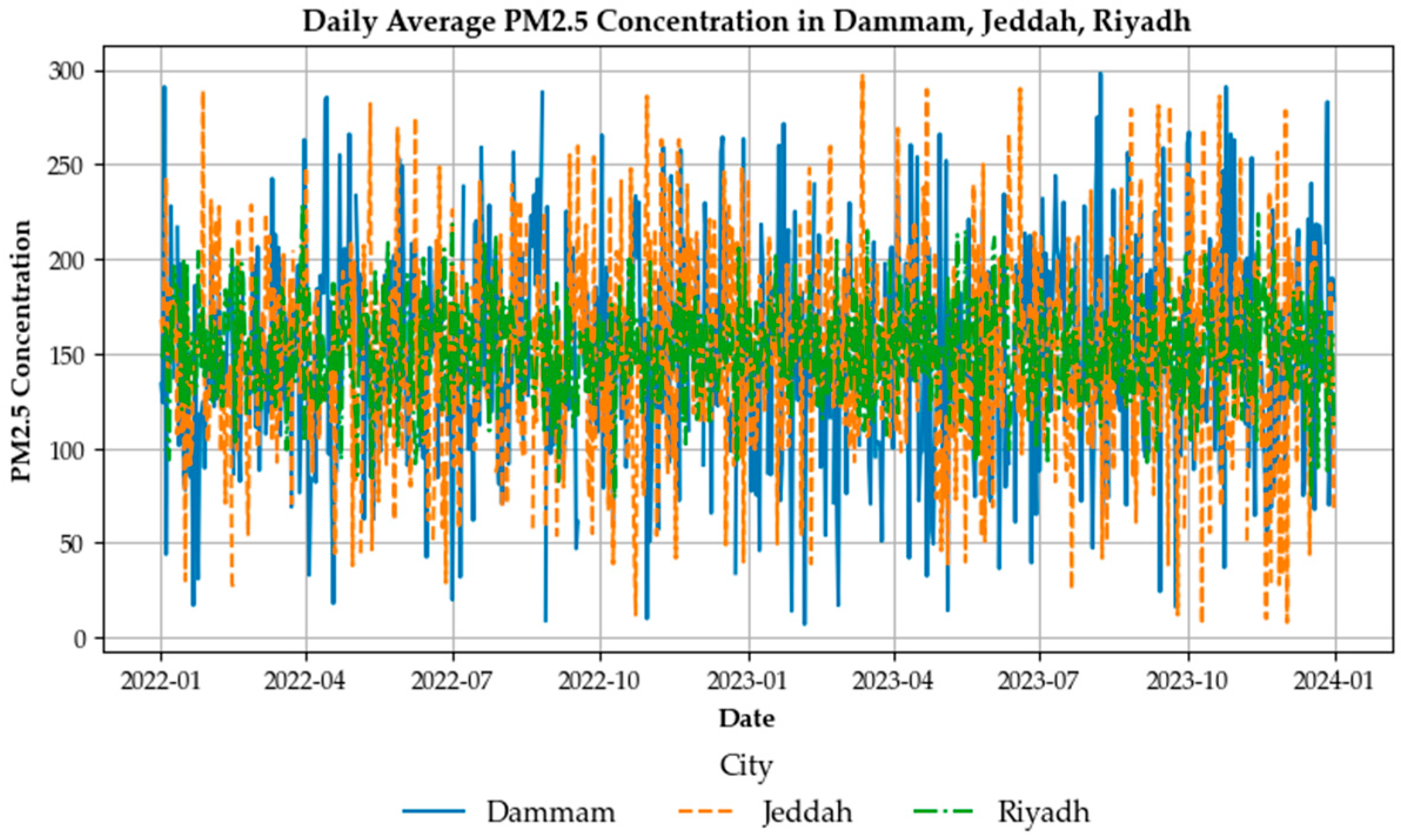

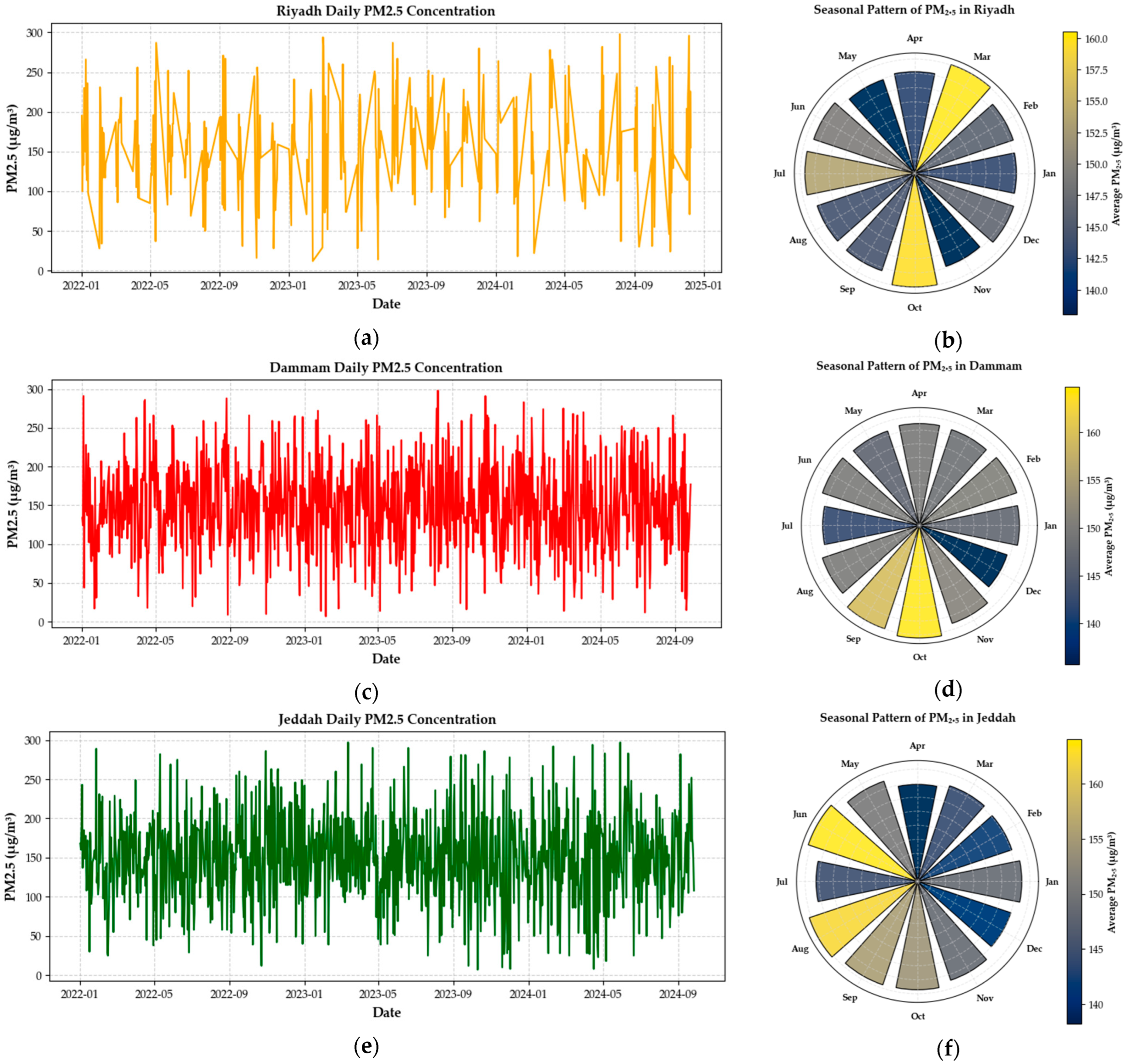
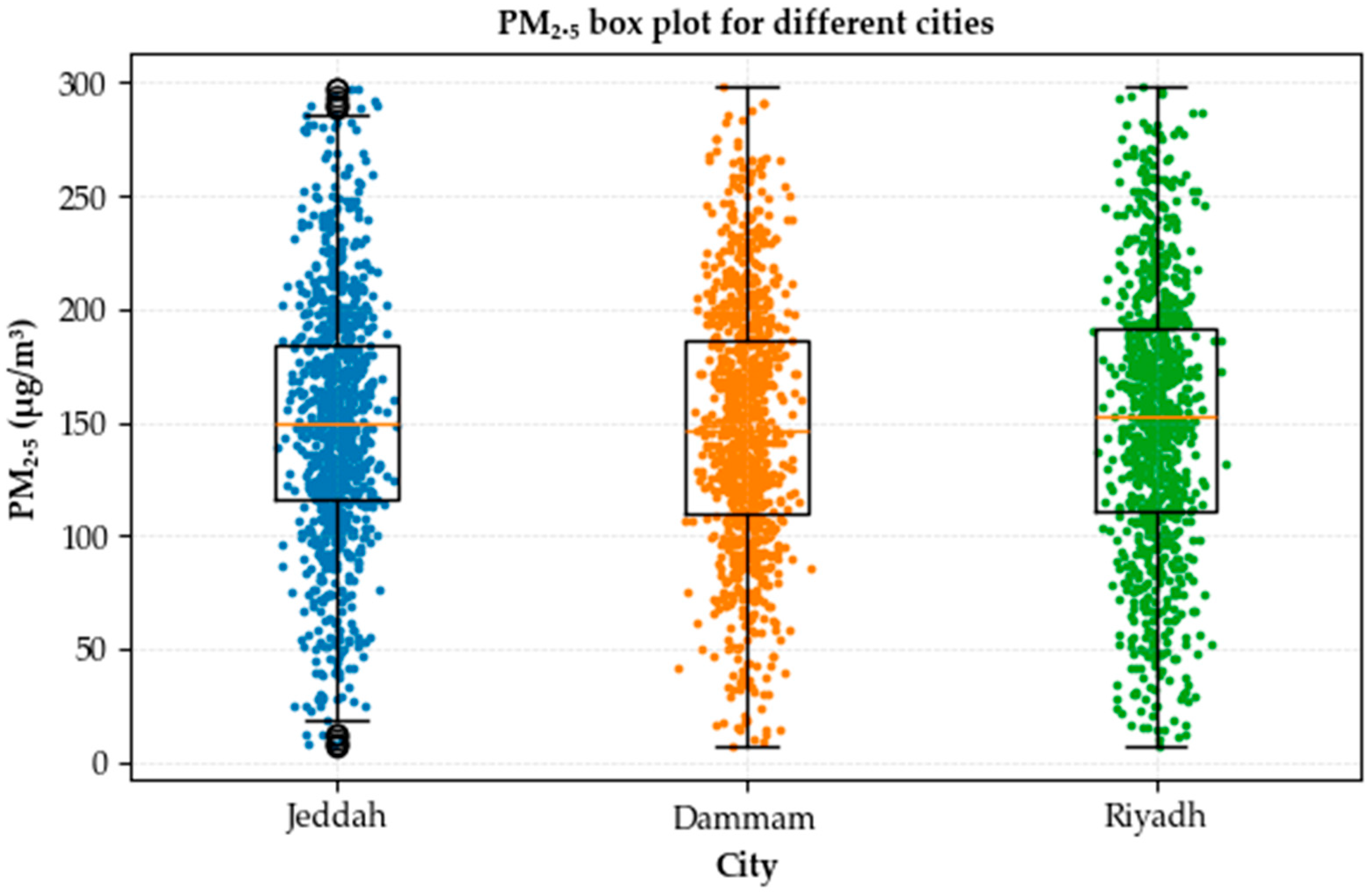


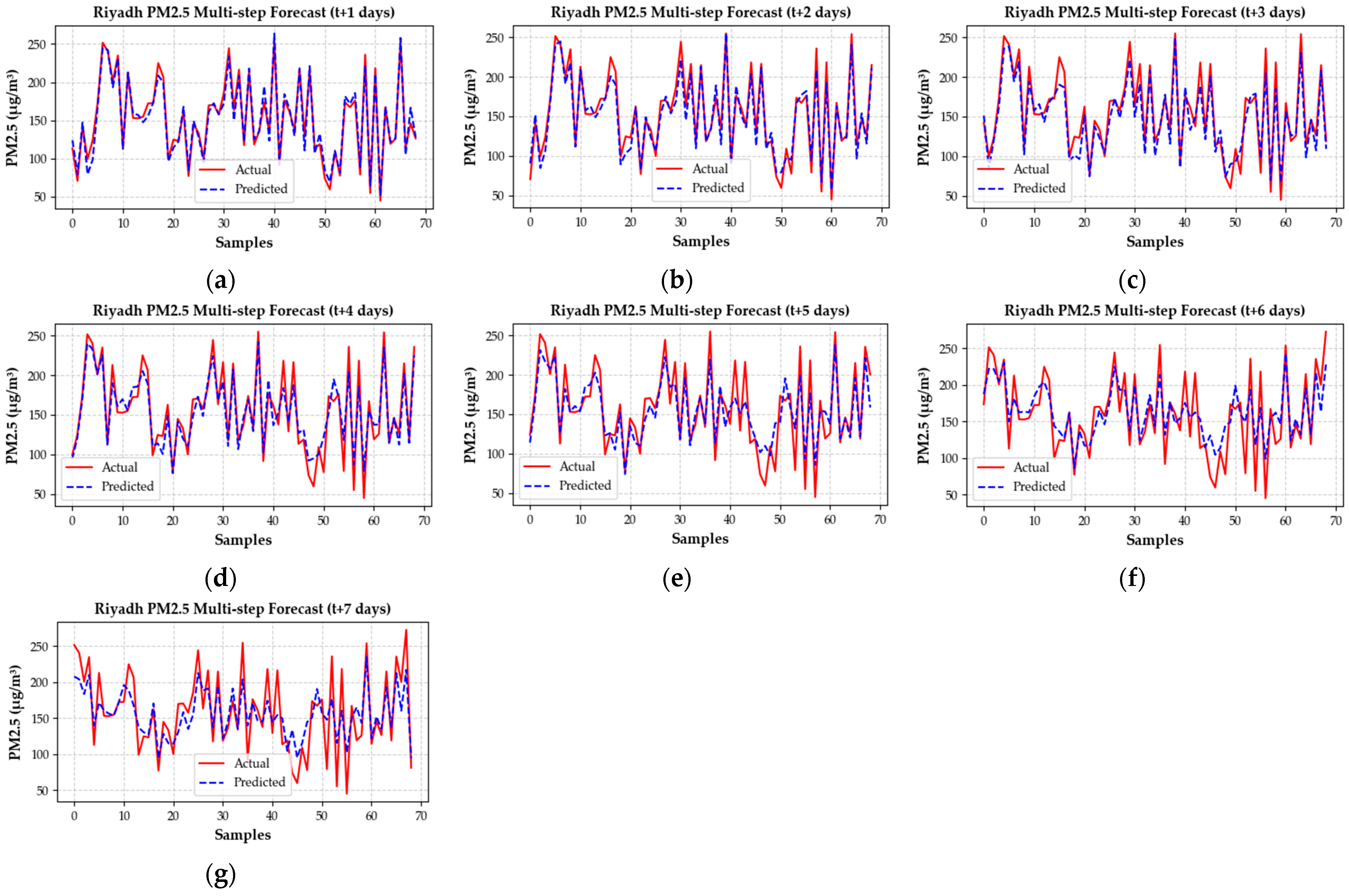
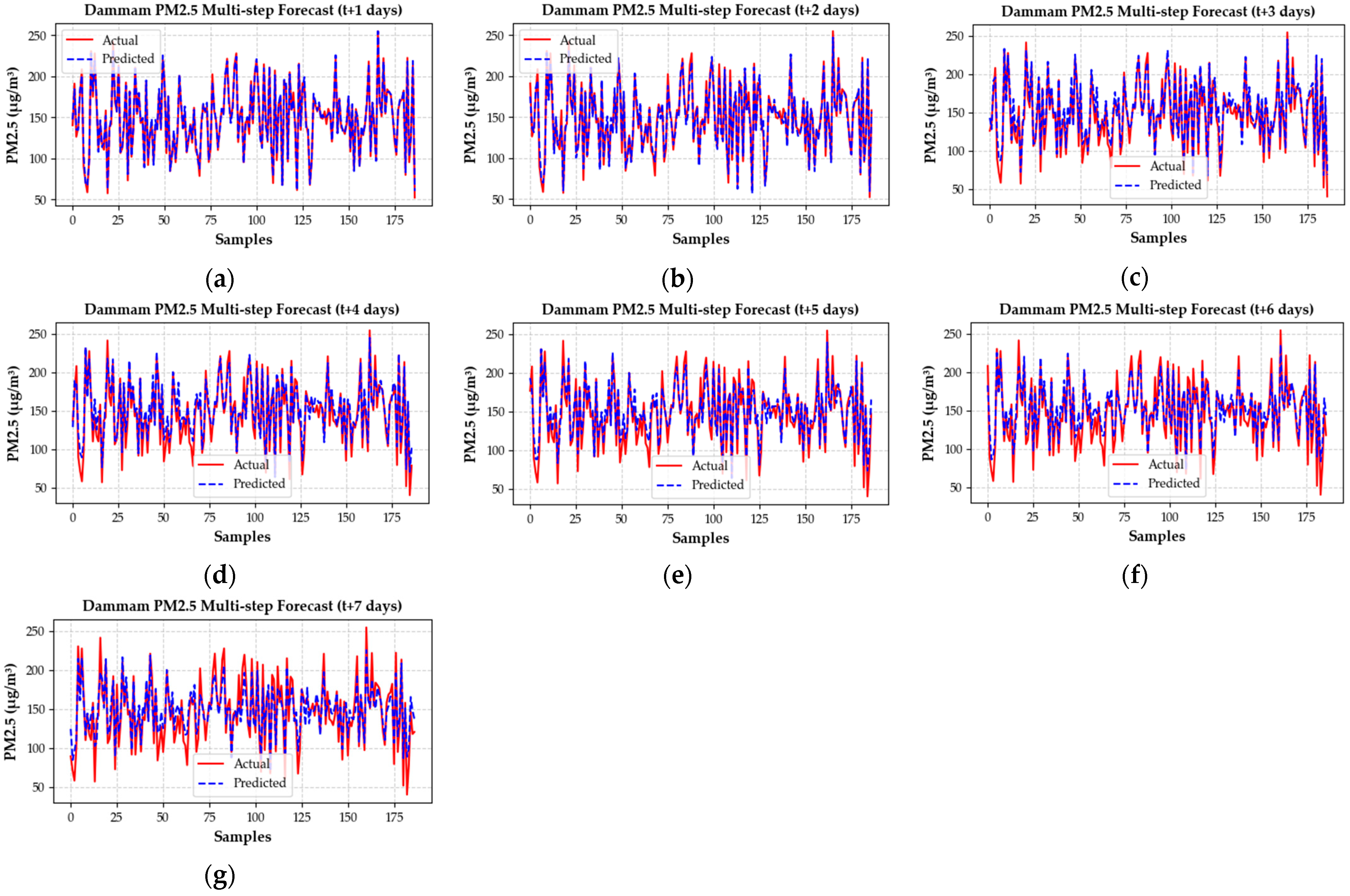
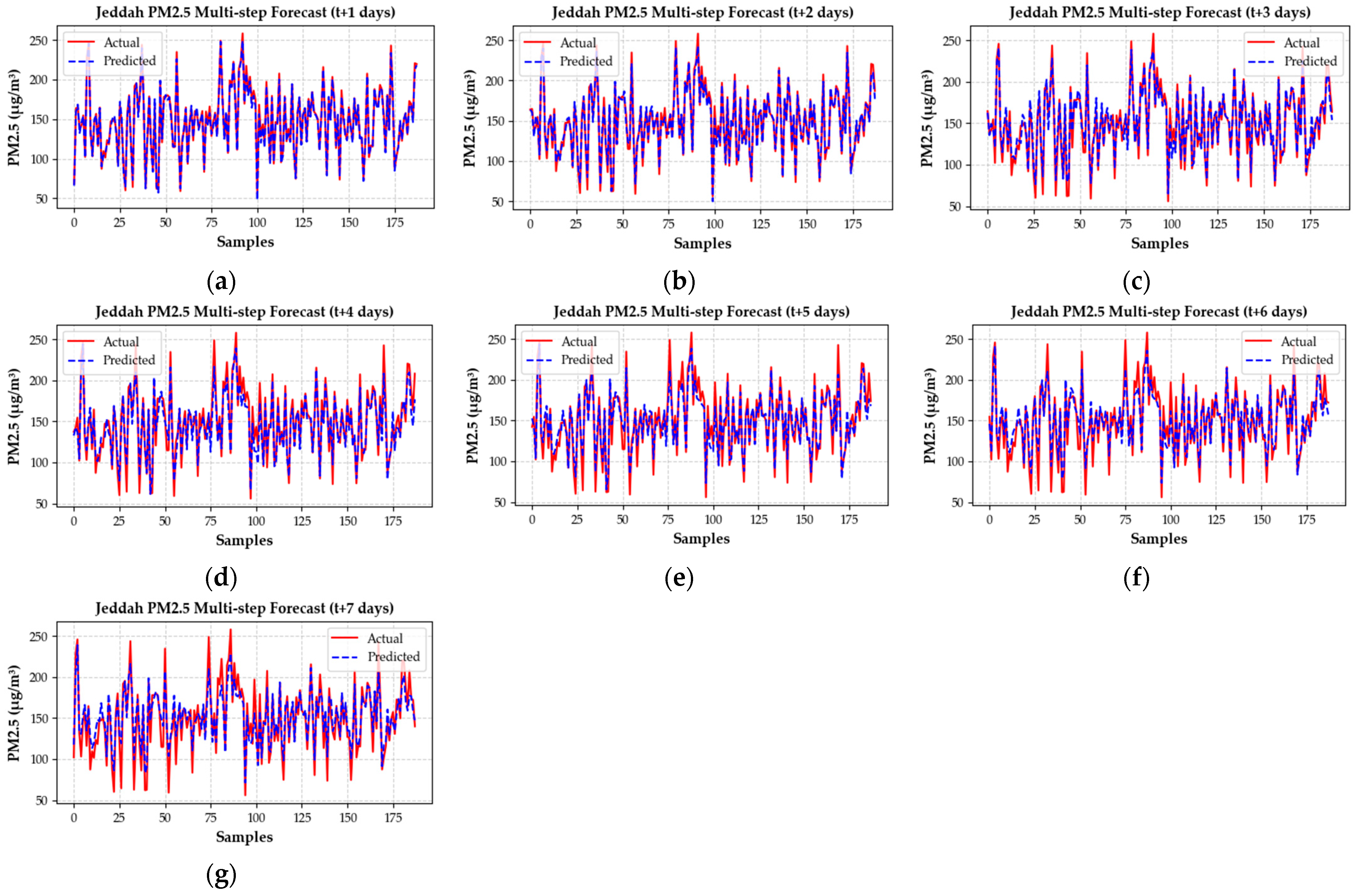
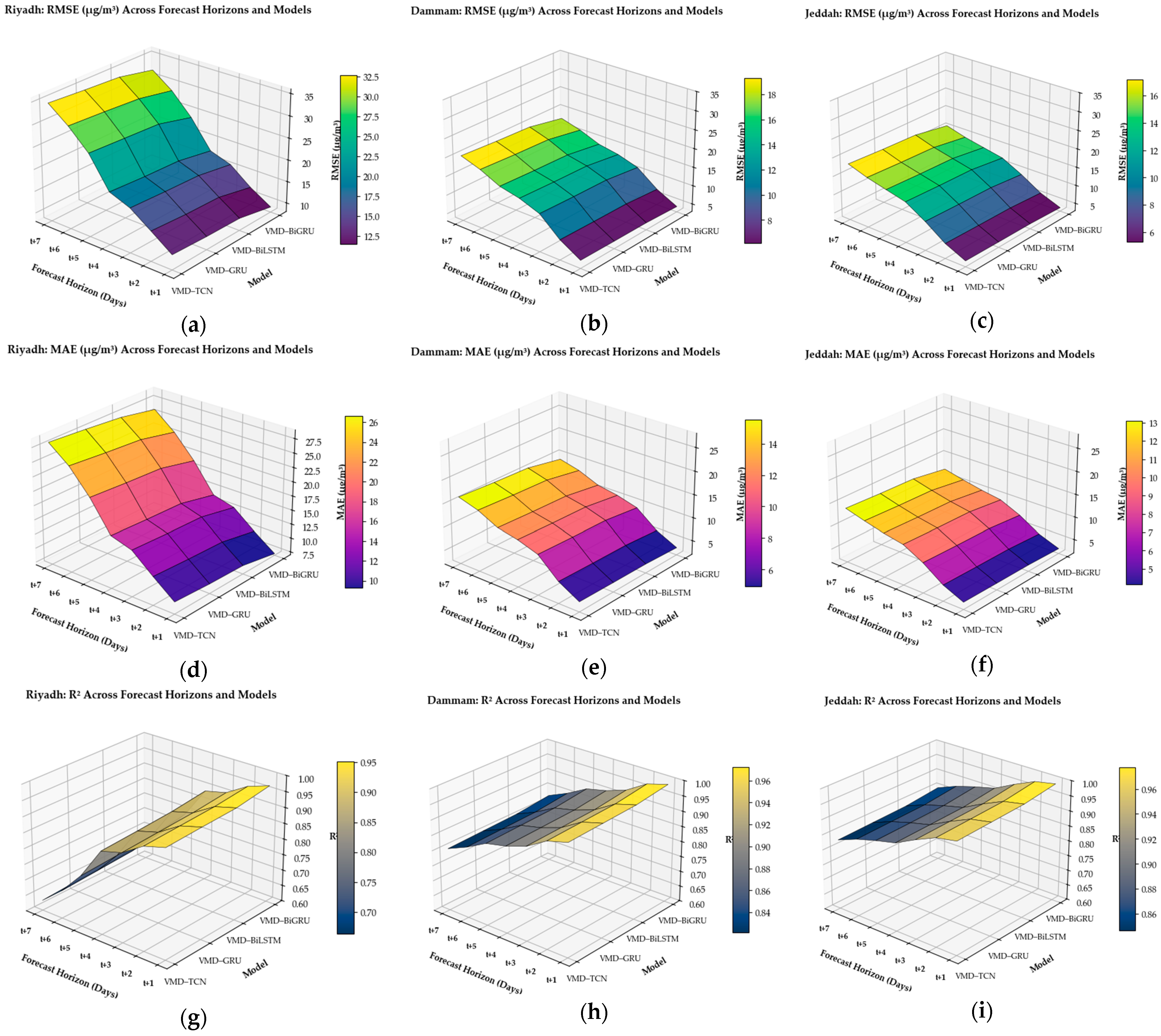
| Region | Model Type | Key Findings | Ref. |
|---|---|---|---|
| Xinyang City, China | Hybrid WCEEMDAN–ILSTM | The model integrates WCEEMDAN for decomposing non-stationary and non-linear PM2.5 data and ILSTM optimized by AMPSO to improve the performance accuracy | [15] |
| Hangzhou, Zhejiang Province, and Kunming, Yunnan Province. | Hybrid CEEMDAN–LSTM–BP–ARIMA | The model applies CEEMDAN to decompose PM2.5 data into modal components and used LSTM, BP, ARIMA, and SVM, to predict PM2.5 | [16] |
| Beijing, China | Hybrid CEEMDAN– DeepTransformer | The model integrates CEEMDAN to decomposed PM2.5 data and then the DeepTransformer network with an improved embedding layer and non-autoregressive direct multi-step decoder resulted in higher long-term prediction accuracy | [17] |
| Kaohsiung, Taiwan | Hybrid CEEMDAN–SVM–LSTM | The model integrates CEEMDAN for extracting IMFs and applies SVM and LSTM models with parameters optimized by the Naive Evolution algorithm to forecast PM2.5 for 1-, 3-, and 7-day horizons | [18] |
| United States | Prophet Time-Series Model | The study applies the Prophet model to nine years (2007–2015) of PM2.5 data from 220 stations. The data was decomposed into trend, seasonality, and holiday components to reveal consistent weekly and yearly PM2.5 patterns | [19] |
| Delhi, India | LSTM, MLFFNN, SVM, RF | The study applies multiple ML and DL models using pollutant and meteorological variables, including aerodynamic roughness coefficient. Results revealed that LSTM achieves the best PM2.5 forecasting accuracy | [20] |
| Patna, Gaya, and Muzaffarpur, India | Stacked DL ensemble (LSTM, CNN, RNN, GRU, Bi-LSTM + XGBoost) | The model employs five DL architectures as base predictors and integrates them through an XGBoost-based stacking ensemble to improved the PM2.5 forecasting accuracy | [21] |
| Delhi, India | Multi-Model Framework (SARIMAX, RF, SVM, ANN, LSTM) | The framework integrates statistical, ML, and DL models with station-specific hyperparameter tuning, exogenous variables, and Fourier-transformed features to capture seasonal PM2.5 variations | [22] |
| United States | RF and SVR (compared with LR, DT, GBR, ABR, XGB, KNN, LSTM, SVM) | The study evaluates nine ML models using PM2.5 data (2017–2021) and finds RF and SVR as the most accurate predictors, showing better performance in the western U.S. due to regional data variability and finer model adaptability. | [23] |
| Hong Kong | Hybrid CNN–LSTM Model | The study compares DL and statistical models (CNN, LSTM, ARIMA, MLE) for hourly PM2.5 forecasting and observed that the hybrid CNN–LSTM achieves the highest accuracy | [24] |
| Lahore, Pakistan | SARIMA Model | The study analyzes air quality and identified that PM2.5 and PM10 levels exceeding NEQS, with strong correlations to O3, NO, and SO2. | [25] |
| Quito, Ecuador | Convolutional-based Spatial Representation (CGM) | The study applies a convolutional spatial regression model (CGM) and reports improved PM2.5 prediction accuracy compared to traditional machine learning models such as Neural Networks, Linear-SVM, and Boosted Trees | [26] |
| Nigeria | CatBoost (compared with SVR, ANN, KNN, DTR, LR) | The study applies multiple ML models using open-source and satellite data with meteorological, demographic, and human activity factors to estimate PM2.5 | [27] |
| Abu Dhabi, UAE | SVR, CNN, and Facebook Prophet | The study compares ML and time series models including DT, RF, SVR, CNN, LSTM, Prophet for PM2.5 and PM10 forecasting using five years of data from six stations. It was observed that SVR and CNN best for short-term (1–2 h) and Prophet best for longer horizons (1 day–1 week) | [28] |
| Malaysia | RF and SVR | The study estimates PM2.5 using satellite AOD, ground pollutants, and meteorological data (2018–2019) across 65 stations and developed seven seasonal and spatial models in which RF model achieved a higher accuracy | [29] |
| Metric | Description | Mathematical Expression |
|---|---|---|
| Mean Absolute Error (MAE) | Represents the average magnitude of forecast errors without considering their direction. It expresses the mean absolute deviation between actual and predicted values. | |
| Mean Squared Error (MSE) | It measures the mean of squared deviation between predicted and observed values and assigns greater weight to large errors. | |
| Root Mean Squared Error (RMSE) | Represents the square root of the mean squared error, showing the standard deviation of prediction errors in the same unit as PM2.5 | |
| Coefficient of Determination (R2) | Indicates the proportion of variance in the observed data explained by the model. A higher R2 implies stronger predictive accuracy. |
| Forecast Horizon (Days) | RMSE (µg/m3) | MAE (µg/m3) | R2 |
|---|---|---|---|
| t + 1 | 9.25 | 7.37 | 0.969 |
| t + 2 | 12.26 | 10.20 | 0.946 |
| t + 3 | 16.05 | 13.27 | 0.905 |
| t + 4 | 17.64 | 14.31 | 0.889 |
| t + 5 | 24.15 | 19.37 | 0.791 |
| t + 6 | 29.03 | 23.32 | 0.716 |
| t + 7 | 32.03 | 26.21 | 0.664 |
| Forecast Horizon (Days) | RMSE (µg/m3) | MAE (µg/m3) | R2 |
|---|---|---|---|
| t + 1 | 4.46 | 3.60 | 0.989 |
| t + 2 | 7.24 | 5.77 | 0.970 |
| t + 3 | 11.34 | 9.24 | 0.929 |
| t + 4 | 13.06 | 10.49 | 0.906 |
| t + 5 | 14.08 | 11.28 | 0.891 |
| t + 6 | 16.23 | 13.11 | 0.855 |
| t + 7 | 17.75 | 14.23 | 0.826 |
| Forecast Horizon (Days) | RMSE (µg/m3) | MAE (µg/m3) | R2 |
|---|---|---|---|
| t + 1 | 3.97 | 3.10 | 0.991 |
| t + 2 | 6.09 | 4.77 | 0.978 |
| t + 3 | 9.36 | 7.44 | 0.948 |
| t + 4 | 12.12 | 9.41 | 0.914 |
| t + 5 | 13.23 | 10.11 | 0.898 |
| t + 6 | 14.36 | 11.02 | 0.879 |
| t + 7 | 15.88 | 12.05 | 0.853 |
Disclaimer/Publisher’s Note: The statements, opinions and data contained in all publications are solely those of the individual author(s) and contributor(s) and not of MDPI and/or the editor(s). MDPI and/or the editor(s) disclaim responsibility for any injury to people or property resulting from any ideas, methods, instructions or products referred to in the content. |
© 2025 by the authors. Licensee MDPI, Basel, Switzerland. This article is an open access article distributed under the terms and conditions of the Creative Commons Attribution (CC BY) license (https://creativecommons.org/licenses/by/4.0/).
Share and Cite
Khattak, A.; Alotaibi, S.; Alahmadi, R.N.; Matara, C.M.; Taglawi, S. Hybrid VMD–BiGRU Framework for Multi-Step Forecasting of PM2.5 in Traffic-Intensive Cities of the Kingdom of Saudi Arabia. Atmosphere 2025, 16, 1324. https://doi.org/10.3390/atmos16121324
Khattak A, Alotaibi S, Alahmadi RN, Matara CM, Taglawi S. Hybrid VMD–BiGRU Framework for Multi-Step Forecasting of PM2.5 in Traffic-Intensive Cities of the Kingdom of Saudi Arabia. Atmosphere. 2025; 16(12):1324. https://doi.org/10.3390/atmos16121324
Chicago/Turabian StyleKhattak, Afaq, Saleh Alotaibi, Raed Nayif Alahmadi, Caroline Mongina Matara, and Sami Taglawi. 2025. "Hybrid VMD–BiGRU Framework for Multi-Step Forecasting of PM2.5 in Traffic-Intensive Cities of the Kingdom of Saudi Arabia" Atmosphere 16, no. 12: 1324. https://doi.org/10.3390/atmos16121324
APA StyleKhattak, A., Alotaibi, S., Alahmadi, R. N., Matara, C. M., & Taglawi, S. (2025). Hybrid VMD–BiGRU Framework for Multi-Step Forecasting of PM2.5 in Traffic-Intensive Cities of the Kingdom of Saudi Arabia. Atmosphere, 16(12), 1324. https://doi.org/10.3390/atmos16121324






